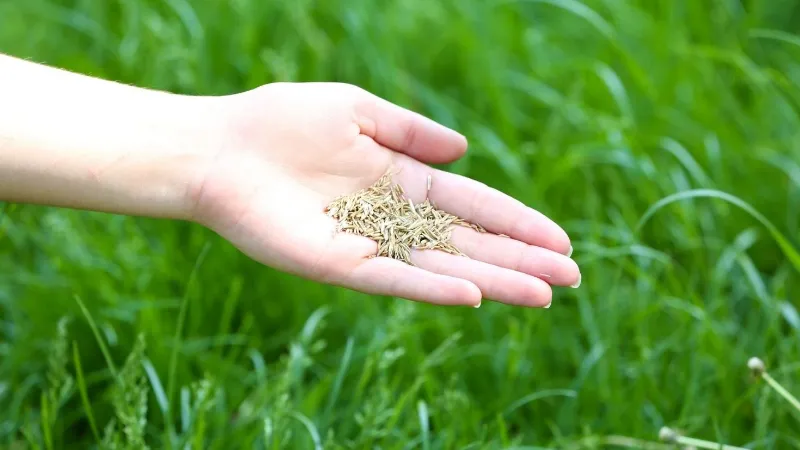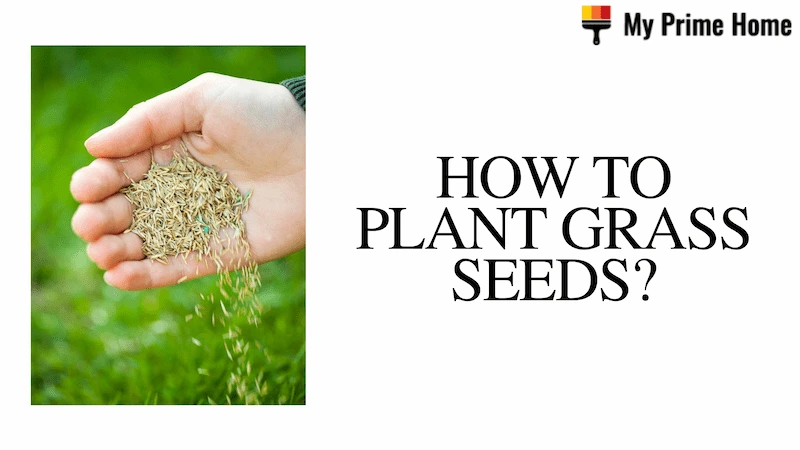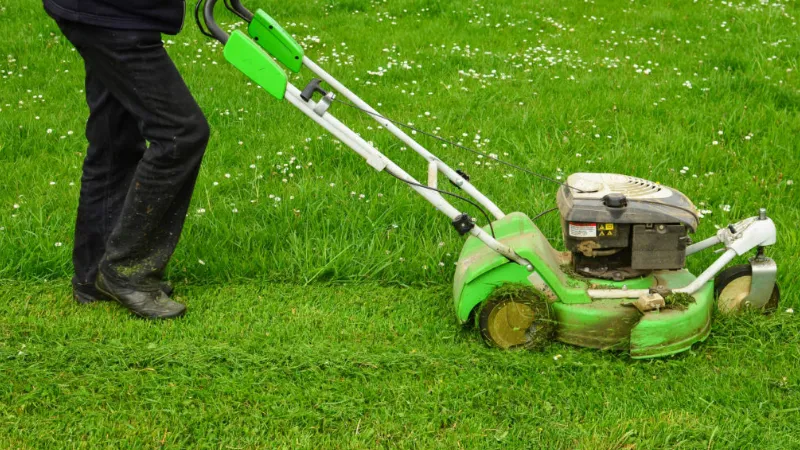When planting grass seeds, it’s easy to figure out “how much grass seed do I need”, but you might need a refresher on your trigonometry from high school. At last, practical use for trig!
Below will give you how much grass seed do I need per square foot, per acre, for overseeding, and for a new lawn.
Please read on for more detailed information.
How Much Grass Seed Do I Need?
Here are the details:
Per Square Foot
Per 1,000 square feet, you will require 3 to 10 pounds of grass seed. ft.
The following factors will dictate how much is needed (high/low)
- Types and varieties of grass (KBG, TTTF, etc.)
2. Overseeding an existing lawn, or
3. Seeding a new lawn on bare dirt
Increments of 1,000 square feet are used to measure lawn care.
For instance, 3 pounds of 24-0-6 fertilizer are required to provide 3/4 pounds of nitrogen per 1,000 square feet. ft. You’ll also use 4 oz. of propiconazole per gallon for every 1,000 sq. ft. to prevent snow mold. And the same goes for grass seeds.
To develop your lawn maintenance strategy, learn how to identify crabgrass. Below will give you a full explanation of what is crabgrass.

Per Acre
Simple and quick math can be used to determine this. One acre is 43,560 square feet. The calculation is 43,560/1,000 = 43.56 because we need the area in square feet. 131 pounds of grass seed are required to overseed a one-acre lawn at a rate of 3 pounds per 1,000 square feet (43.56 * 3 = 130.68).
For Overseeding
Choosing the right kind of grass seed is important when overseeding. You will receive various pounds per 1,000 square feet for cool-season lawns, such as Kentucky Bluegrass (KBG), Perennial Ryegrass (PRG), and Tall Fescue (TTTF). ft.
Kentuckey Bluegrass grass seeds are much smaller than Perennial Ryegrass and Turf Type Tall Fescue grass seeds, and a pound of KBG can contain up to 6 times as many seeds as PRG and TTTF combined.
KBG is also rhizomatic, which means the grassroots not only grow downward but also laterally in the soil and back upwards through the soil with new grass growth. This self-repairing grass type is a great addition to mix with other cool-season grasses.
This shares similarities with other rhizomatic grasses like Bermuda, a warm-season grass.
2 pounds of Kentucky bluegrass per 1,000
5 pounds of perennial ryegrass per 1,000
Tall Fescue: 5 lbs. per 1,000
For a New Lawn
We can calculate the cost after you have determined the total square footage of your lawn and selected the preferred grass blend.
When seeding a brand-new lawn, we advise using no less than 7 pounds of grass seed per 1,000 square feet of bare ground. ft.
Keep extra seed on hand to fill in any uneven or bare spots on your lawn to avoid having a patchy lawn.
Bluegrass from Kentucky: 4 lbs. per 1,000
10 pounds of perennial ryegrass per 1,000
Tall Fescue: 10 lbs. per 1,000
Some general seeding rates:
Three to six (3-6) pounds per 1000 square feet should be used to overseed an existing nice lawn.
An existing, subpar lawn should be overseeded with six to eight (6–8) pounds of seed per 1000 square feet.
Seeding new yard on bare ground: Eight – ten (8 -10) pounds per 1000 square feet.

Does It Matter How Much Lawn Seed I Use?
Well, naturally, if it didn’t matter, this article would be brief.
Understanding your lawn’s square meterage is crucial in the first place.
With a square or rectangular lawn, that is fairly simple. But what if your lawn is circular or triangular? Or even worse: an irregularly shaped lawn?
Relax; we’ll show you how to calculate the size of each lawn, so don’t be alarmed. And then, we’ll show you how to work out how much grass seed you need for perfect coverage.
But in answer to the question “does it matter how much lawn seed I use”:
- if you use too little seed, the results will be patchy and inconsistent
- if you use too much seed, it’s a waste because there’s only so many grass plants your soil can support
Can you mow wet grass? Short answer: No. Whether it’s early morning and the lawn is still dewy, a rainstorm just ended, or you just ran your sprinklers, you should skip the mow for now. Please read on for more detailed information.
Grass Seed Sowing Rates
Here are some scenarios where higher and lower grass seed sowing rates would be appropriate.
Minor repairs
Most homeowners use excessive amounts of seed for small areas that only need minor repairs, which results in dense tufts. In these circumstances, only 25 grams per square meter are required.
Mowing your lawn
If you wish to keep your lawn as short as is tolerable for the type of grass that you have, then increase the sowing rates by 20-30% above the highest recommended rate.
Clean seed bed
It takes time to make weed-free soil when starting a new lawn. Although it will take longer to establish and thicken, you can use up to 50% less seed if you take this approach. Add 20% to the higher seeding rate if you simply dug the weeds in rather than removing them.
If you are seeding in unfavorable weather (cold or dry), boost seeding rates by up to 100% to make up for losses.
The majority of seeds, however, won’t germinate in temperatures below 8°C or in overly dry conditions. But, How Long Does Grass Seed Last?

FAQs
Can I Plant Too Much Grass Seed?
Too much grass seed causes undue competition for resources such as light, water and nutrients, and grass seedlings struggle as a result. Too little seed leaves lawns thin or bare.
How Do You Calculate Seed Size?
Seed size can be measured in terms of the number of seeds per pound. The “normal” range is about 14,000-16,000 seeds per pound, but it can range from 10,000 seeds per pound to more than 18,000 seeds per pound.
Do You Just Scatter Grass Seed?
We recommend using a spreader but if you are doing it by hand, use string to divide the area into sections before sowing your seed. This makes it easier to manage how much seed you plant. The seed should be sown between 5 and 10 millimeters deep in the ground.
Should You Water Grass Seed a Lot?
Normally a lawn should be watered deeply but infrequently, but when you are watering for new grass seed, you must water every day. Early in the morning and again at midday, set automatic timers for 5 to 10 minutes each. It’s important to apply water evenly and consistently, whether it’s with hose end sprinklers or by hand.
Summary: How Much Grass Seed Do I Need?
Because grass seed typically costs less than turf, you can afford to round up when estimating quantities.
10% should be added for mismeasuring, 10% for seeds eaten by the birds and an additional 10% for filling in any thin spots around a month after sowing. This translates to about a third more seed than is necessary for the measured area. Any surplus can be saved for future lawn maintenance, so it won’t go to waste.
If you have any questions, please leave a comment. My Prime Home tries to give you the best home improvement information. Don’t forget to share the post. Thank you for reading.
Read about How to Get Rid of Grasshoppers?



